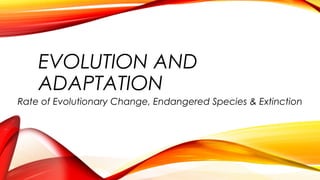Rates of evolutionary change and extinctions
•Download as PPT, PDF•
2 likes•2,082 views
Rates of evolutionary change and extinctions
Report
Share
Report
Share

Recommended
Recommended
More Related Content
What's hot
What's hot (20)
Viewers also liked
Viewers also liked (8)
Testing for heterogeneity in rates of morphological evolution: discrete chara...

Testing for heterogeneity in rates of morphological evolution: discrete chara...
Effects of ancestral character estimation on methods for estimating rates of ...

Effects of ancestral character estimation on methods for estimating rates of ...
Ap Chapter 26 Evolutionary History Of Biological Diversity

Ap Chapter 26 Evolutionary History Of Biological Diversity
Similar to Rates of evolutionary change and extinctions
Similar to Rates of evolutionary change and extinctions (20)
Ecology and Biodiversity introduction Lecture 1.ppt

Ecology and Biodiversity introduction Lecture 1.ppt
Topic 4.2 evaluating biodiversity and vulnerability

Topic 4.2 evaluating biodiversity and vulnerability
More from Jessi Dildy
More from Jessi Dildy (20)
I kingdom fungi –characteristics & reproduction 2016

I kingdom fungi –characteristics & reproduction 2016
Special features for flight,3 mammal reprod groups & endoskeleton vs exoskeleton

Special features for flight,3 mammal reprod groups & endoskeleton vs exoskeleton
Recently uploaded
God is a creative God Gen 1:1. All that He created was “good”, could also be translated “beautiful”. God created man in His own image Gen 1:27. Maths helps us discover the beauty that God has created in His world and, in turn, create beautiful designs to serve and enrich the lives of others.
Explore beautiful and ugly buildings. Mathematics helps us create beautiful d...

Explore beautiful and ugly buildings. Mathematics helps us create beautiful d...christianmathematics
Recently uploaded (20)
Unit-V; Pricing (Pharma Marketing Management).pptx

Unit-V; Pricing (Pharma Marketing Management).pptx
Explore beautiful and ugly buildings. Mathematics helps us create beautiful d...

Explore beautiful and ugly buildings. Mathematics helps us create beautiful d...
Kodo Millet PPT made by Ghanshyam bairwa college of Agriculture kumher bhara...

Kodo Millet PPT made by Ghanshyam bairwa college of Agriculture kumher bhara...
Basic Civil Engineering first year Notes- Chapter 4 Building.pptx

Basic Civil Engineering first year Notes- Chapter 4 Building.pptx
On National Teacher Day, meet the 2024-25 Kenan Fellows

On National Teacher Day, meet the 2024-25 Kenan Fellows
Unit-IV; Professional Sales Representative (PSR).pptx

Unit-IV; Professional Sales Representative (PSR).pptx
General Principles of Intellectual Property: Concepts of Intellectual Proper...

General Principles of Intellectual Property: Concepts of Intellectual Proper...
Seal of Good Local Governance (SGLG) 2024Final.pptx

Seal of Good Local Governance (SGLG) 2024Final.pptx
Rates of evolutionary change and extinctions
- 1. EVOLUTION AND ADAPTATION Rate of Evolutionary Change, Endangered Species & Extinction
- 2. Rates of Evolutionary Change: Gradualism • Evolutionary change that occurs slowly and constantly over time • Based on evidence from fossil record where some organisms have evolved slowly (in geological time) • Modern organisms have changed very little from ancient organisms • Ex. Sharks, crocodiles, horseshoe crabs, cockroaches
- 3. Rates of Evolutionary Change: Punctuated Equilibrium • Long periods of stability where little change occurs followed by periods of rapid change to a species • Caused by environmental conditions such as an ice age. Some species die off, others are able to adapt quickly and survive • Animals with higher reproductive rates are better able to adapt. • Ex. Mammals, birds
- 5. Endangered Species • Species considered likely to become extinct are categorized by the International Union for Conservation of Nature (IUCN) • Red List Species are ranked according to their risk of extinction Percent of total species considered threatened by the IUCN Critically Endangered Endangered Vulnerable
- 6. Endangered Species & Extinction • Extinction can be natural part of evolution as species fail to adapt to a changing environment and less fit organisms do not survive. • Human caused/influenced sources of extinction: • Poaching/Hunting • Habitat destruction • Invasive species • Pollution • Climate change • What else?
- 7. Something to think about • Compare the graph of worldwide threatened species and the numbers of Canadian threatened species • What group is most at risk worldwide? In Canada? • Why the difference? • Hypothesize why these groups are especially threatened? • Which group is least at risk? Why?
- 8. What is it?
- 10. Extinction • Complete disappearance of a species from Earth • Background extinction – Ongoing extinctions of a few species at a time due to failure to adapt, competition, etc. • Mass extinction – Extinction caused by catastrophic event that eliminates majority of species. Meteor strike, ice age, climate change etc • Major geological eras are marked by mass extinctions • Extinctions leave open niches for other species to adapt to and fill • Extinctions increase speciation